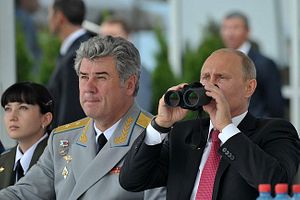A number of recent events indicate that Iran and Russia are expanding defense ties amid a growing congruence of interests between the two countries on issues such as Syria and opposition to U.S. activism.
This week Gen. Viktor Bondarev, the head of Russia’s Air Force, visited Tehran where he met with Brig. Gen. Amir Ali Hajizadeh, the commander of the Revolutionary Guards’ air division, and Brig. Gen. Farzad Esmaili, the head of an IRGC-controlled engineering firm’s air defense division.
Much of the coverage of Bondarev’s visit in the Iranian press featured the Russian commander praising the growing capabilities of Iran’s defense industry. One report indicated that Bondarev was particularly impressed by the modifications Iranian defense companies made to the Russian-made S-200 missile defense systems that Moscow sold Tehran.
As reported widely by international media outlets, Iran also presented Russia with a drone it claims to have reversed engineered from the U.S.-made ScanEagle drone that Iran captured late last year. Iran also reportedly provided the Russian military delegation with videos showing how it monitors foreign militaries’ activities and presence in the Persian Gulf.
Another report said that during a meeting earlier this week, Bondarev and Esmaili vowed to boost defense cooperation between Iran and Russia’s Air Forces, and also exchanged “information, air defense techniques, electronic and radar as well as missile systems.” Brig. Gen. Hassan Shah Safi, the commander of Iran’s regular Air Force (Iran has a dual military structure with a regular military and the Islamic Revolutionary Guards Corps (IRGC), also met with Bondarev and the two reportedly signed an agreement to enhance missile and defense cooperation. Few details of the agreement were made public.
A more contentious issue discussed during the visit was Russia’s failure to sell Iran its S-300 air and missile defense systems. Moscow originally agreed to sell Iran its sophisticated S-300 system in 2007 but in 2010 it announced that it had decided to not honor the initial contract. The reversal was almost certainly due to intense U.S. pressure. The move prompted Iran to sue Russia for US$4 billion, despite the original contract only being worth US$800 million.
There have recently been indications that the two nations are actively seeking a way to resolve the dispute over the S-300 systems. Back in June it was reported that Russia had offered to sell Iran a S-300 replacement, the Tor anti-aircraft missile system, but Iran promptly rejected the offer. Reports in semi-official Iranian media outlets this week suggest that Iran is interested in acquiring Russia’s Antei-2500 system as an alternative to the S-300 systems.
Bondarev’s visit was not the only recent indication that Iran and Russia are boosting military ties. Earlier this month Iran’s Navy Commander, Rear Admiral Habibollah Sayyari, told reporters that a flotilla of Russian warships would be making a port call in Iran in the near future.
“The Russian flotilla of warships will visit Iran in the near future," Sayyari said at the time.
This visit is consistent with the growing frequency with which Russian and Iranian naval vessels are making port calls in each other’s countries. In 2012 Russian naval vessels made two port calls in Iran’s Bandar Abbas port in the Persian Gulf. Two Iranian naval vessels made reciprocal visits to Russia in late June and early July of this year.
Iran has traditionally seen Russia as a rival owing to its relatively close geography and propensity to meddle in Iranian affairs. The last major conflict between the two nations was the Russo-Persian War (1826-1828) in which Moscow defeated Iran and forced it to sign the Treaty of Turkmenchay (1828) surrendering significant parts of the Persian Empire at the time. The treaty is still remembered bitterly by many in Iran.
The Soviet Union also occupied the northern half of Iran during WWII as the Persian Gulf country was used as a major transit point in the U.S. and U.K.’s efforts to supply the Soviet Union in its fight against the Nazis under the lend-lease agreement. Although the Allies had agreed to withdraw from Iran immediately following the war, Moscow initially failed to honor this agreement and only left the country after the Harry Truman administration issued an ultimatum to Soviet leaders. Later, the Soviet invasion of Afghanistan in 1979 greatly concerned leaders of the Islamic Republic of Iran.
The Iranian-Russian relationship has improved greatly in the post-Cold War era, however. This has included Russia becoming one of Iran’s top foreign suppliers of arms since the two nations negotiated their first modern agreement in 1992. Although Russia struck a deal with the U.S. in the middle of the 1990s to stop selling Iran advanced conventional weaponry, this agreement proved temporary. According to the Council on Foreign Relations (CFR), as Iran’s defense cooperation with China and North Korea declined in the late 1990s, Russia filled the vacuum left in their place, ultimately becoming Iran’s top arms supplier.
“The value of arms transfer agreements between the Iran and Russia ballooned from $300 million between 1998 and 2001 to $1.7 billion between 2002 and 2005,” CFR noted in a backgrounder on the subject of Russian arms sales to Iran.































